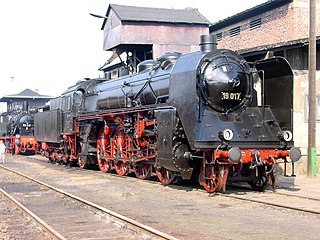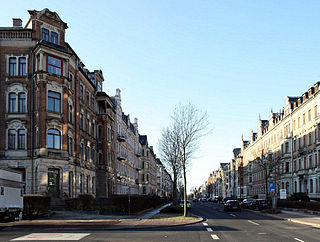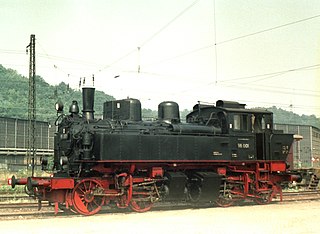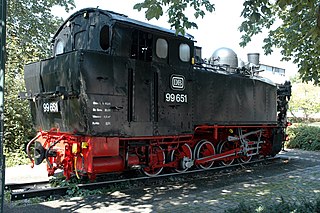
Richard Hartmann (8 November 1809 – 16 December 1878) was a German engineering manufacturer.

Richard Hartmann (8 November 1809 – 16 December 1878) was a German engineering manufacturer.
Hartmann was born on 8 November 1809 in Barr, Bas-Rhin, the son of a tawer (Weissgerber, a tanner of white leather). In his Alsace homeland he learnt the trade of a toolmaker (Zeugschmied). In 1828 his years of travel as a journeyman began, ending up in 1832 in Chemnitz, allegedly with only 2 talers in his pocket. In Chemnitz, Hartmann began to work for various factory owners. One of his employers was Carl Gottlieb Haubold, the founder of the Chemnitz Engineering Works (Chemnitzer Maschinenbau). In Haubold's company, Hartmann rose from journeyman to foreman (Akkordmeister). In 1837 he earned became a citizen. That same year he left Haubold's factory and bought an engineering shop with his colleague, Karl Illing, in Annaberger Strasse at the foot of the Kassberg. Here, Hartmann and Illing repaired cotton-spinning machines, together with three journeymen. The business flourished and after a short time it took on the manufacture of complete spinning machines.

In 1839 Hartmann fell out with Illing and founded the firm of "Götze & Hartmann" with August Götze, in which Götze was responsible for the commercial side and Hartmann for the technical aspects. In the same year Hartmann secured the rights to a slubbing frame (a type of wool spinning machine) for 1000 talers from a penniless inventor. This proved to be the beginning of a breakthrough for the company, which at that time numbered about 30 workers. These slubbing frames established Hartmann's reputation as a spinning machine producer beyond the Chemnitz area. In 1840 the growing company, which already had 76 employees, moved to new premises in Gablenz, but just a year later it outgrew those and the firm moved again to Chemnitz's Klostermühle. Its range of products had expanded in the meantime. In 1840 the firm delivered its first steam locomotive. In 1843 Richard Hartmann was awarded a gold medal for a new spinning machine. In 1844 Hartmann moved his company again and found new sheds at what later became Hartmannstrasse. At that time he employed about 350 workers. That year the company also set up its own iron foundry.
The year 1848 was a milestone in the life of Richard Hartmann and his company. Together with Theodor Steinmetz the firm succeeded in manufacturing its first steam locomotive. The Saxon state government had supported the step towards locomotive construction with a credit of 30,000 talers in order to be able to develop its own locomotive manufacturing base that was not reliant on imports. The Hartmann locomotives proved to be competitive against their English counterparts and were exported worldwide in the decades that followed (especially to Canada, Argentina, Brazil, Turkey and Indonesia). Hartmann became the main supplier to the Royal Saxon State Railways, but he was far-sighted enough not to concentrate exclusively on locomotive construction. At the end of the 1850s the production portfolio of his firm including the manufacture of turbines and mill equipment, mining machinery, drilling equipment and heavy machine tools. In 1857 his company numbered 1500 employees.
In 1870 the company became the Sächsische Maschinenfabrik vormals Richard Hartmann AG . At that time it had a work force of 2700. Hartmann took over the chairmanship of the board.
Richard Hartmann lived in the immediate vicinity of his factory in a villa on Kassbergstrasse. He died here on 16 December 1878 following a stroke.

From 1874-77 he had a summer residence known as Villa Hartmann built on the banks of the Elbe river at Laubegaster Ufer 34 in Dresden-Laubegast by the architects Hübner & Baron in the style of Gottfried Semper. This villa was used by his son Gustav Hartmann (1842-1910, German engineering manufacturer and CEO of Dresdner Bank) from 1881 as his house. The villa is still used today and can be visited on anniversaries.
In 1880 the road nearest the factory was named Hartmannstrasse. The Vierfeld sports hall, opened in 2002 on the site of the former factory, and the Chemnitz vocational school also bear his name. Of the former factory structures only a few remain, of which one is under a preservation order, the engineering building known as the Richard-Hartmann-Halle and the former headquarters building which is now used by the police service.
Richard Hartmann was one of the most important Saxon businessmen and the most successful factory owner in Chemnitz in the 2nd half of the 19th century. He was an important trailblazer and pioneer for engineering in Saxony, which gained worldwide reputation through his efforts. [1] Hartmann succeeded in establishing a locomotive construction industry in Saxony that rivalled that in England. The Sächsische Maschinenfabrik that he founded was the largest company in Saxony [2] and played a role in Chemnitz becoming one of the greatest industrial centres in Germany after 1870.
The Industrieverein Sachsen 1828 (Industrial Society of Saxony) presents a "Richard Hartmann" award, with €5000 of prize money, for outstanding industry-related, scientific, technical and economic successes with a high degree of innovation.

The German Class 99.73-76 engines were standard locomotives (Einheitslokomotiven) in service with the Deutsche Reichsbahn for Saxony's narrow gauge railways. Together with their follow-on class, the DR Class 99.77-79, they were the most powerful narrow gauge locomotives in Germany for the 750 mm track gauge.

The Royal Saxon State Railways were the state-owned railways operating in the Kingdom of Saxony from 1869 to 1918. From 1918 until their merger into the Deutsche Reichsbahn the title 'Royal' was dropped and they were just called the Saxon State Railways.

Maschinenfabrik Esslingen (ME), was a German engineering firm that manufactured locomotives, tramways, railway wagons, roll-blocks, technical equipment for the railways,, bridges, steel structures, pumps and boilers.

The Saxon Class XII H2 steam locomotives were bought by the Royal Saxon State Railways specifically for the mountainous areas of Saxony. They were built by Hartmann between 1910 and 1927 in Chemnitz. The design of this passenger train locomotive was carried out in parallel with that of the express train classes, the Saxon X H1 and Saxon XII H. A total of 159 examples of this powerful locomotive were built by 1922.
The Saxon Class XVIII was a German six-coupled tender locomotive built for the Royal Saxon State Railways in 1917/18 for express train services. The Deutsche Reichsbahn grouped them in 1925 into DRG Class 18.0.

The Saxon Class XX were German eight-coupled express train, tender locomotives built for the Royal Saxon State Railways just after the First World War. The locomotives, which became known as the 'Pride of Saxony' (Sachsenstolz) were the first and only German express locomotives with a 2-8-2 wheel arrangement and, at the time of their appearance, were the largest express engines in the whole of Europe. In 1925, the Deutsche Reichsbahn grouped these locomotive into their DRG Class 19.0.

The Sächsische Maschinenfabrik in Chemnitz was one of the most important engineering companies in Saxony in the second half of the 19th century and the first two decades of the 20th century. Including its various predecessor businesses, the firm existed from 1837 until its liquidation in 1930, and individual branches of the company taken over by others continued to operate until 1990. The company is closely linked with the name of its founder and long-time manager, Richard Hartmann, whose name formed part of the new company title in 1898: the Sächsische Maschinenfabrik vormals Richard Hartmann.

The Saxon Class V K were German 0-8-0T narrow gauge steam locomotives operated by the Royal Saxon State Railways which had been primarily intended for the Müglitztalbahn. In 1925 the Deutsche Reichsbahn incorporated arranged these locomotives as DRG Class 99.61.
The Royal Saxon State Railways designated four-coupled, Atlantic (4-4-2) express locomotives as Class X and the Deutsche Reichsbahn subsequently grouped these locomotives into DRG Class 14.2 in 1925.

The Pegasus was an early, passenger train tender locomotive operated by the Leipzig–Dresden Railway Company or LDE. She was one of the first locomotives to be built in Germany.
The RICHARD HARTMANN to ZWICKAU series of early German locomotives were express train tender locomotives operated by the Leipzig–Dresden Railway Company.

The Saxon Class VII T were twin-coupled tank engines of the Royal Saxon State Railways designed for branch line (Sekundärbahn) operations. In 1925, the Deutsche Reichsbahn grouped these locomotives 1925 into their Class 98.70.

Kaßberg is the most densely populated neighbourhood within the German city of Chemnitz and belongs to the largest Gründerzeit and Art Nouveau neighbourhoods in Germany. It is near the Chemnitz River and is to the west of the Chemnitz city centre. Its highest point is about 30 metres above the level of the city centre.

The Saxon Class IIIb was a twin-coupled tender locomotive built for passenger services with the Royal Saxon State Railways.

Carl Robert Wagner was a German entrepreneur and draftsman. As founder of the company Rowac, he was responsible for bringing the first industrially produced steel stool to market.

The Saxon class I T were a class of 19 German 0-4-4-0 Meyer tank locomotives built for the Royal Saxon State Railways for service of the Windbergbahn. The Deutsche Reichsbahn assigned them to Class 98.0.
The Saxon class M I TV was a class of two German 0-4-4-0 Meyer tank locomotives built for the Royal Saxon State Railways

The Saxon VI K were a class of 750-mm gauge 0-10-0T locomotives of the Royal Saxon States Railways with a gauge of 750 mm. In 1925 the Deutsche Reichsbahn (DRG) grouped the locomotives into class 99.64–65; from 1923 to 1927 the procured more locomotives of this type which were grouped in to class 99.67–71.

The Saxon III K were a class of six 0-6-2T locomotives of the Royal Saxon State Railways with a track gauge of 750 mm. In 1925, the Deutsche Reichsbahn grouped these locomotives into their DRG Class 99.754.
The Saxon I F was a class of one 0-4-0 fireless steam locomotive built for the Royal Saxon State Railways.